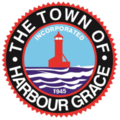Harbour Grace | |
|---|---|
| Town of Harbour Grace | |
 Harbour Grace water front c. 1911 | |
Location of Harbour Grace in Newfoundland | |
| Coordinates: 47°41′30″N53°13′00″W / 47.69167°N 53.21667°W | |
| Country | |
| Province | |
| Settled | 1583 |
| Incorporated | July 10, 1945 |
| Government | |
| • Type | Town Council |
| • Mayor | Terry Barnes |
| • MP | Paul Connors |
| Area | |
• Total | 33.71 km2 (13.02 sq mi) |
| Elevation | 16 m (52 ft) |
| Population (2021) | |
• Total | 2,796 |
| • Density | 88.8/km2 (230/sq mi) |
| Time zone | UTC-3:30 (Newfoundland Time) |
| • Summer (DST) | UTC-2:30 (Newfoundland Daylight) |
| Postal code span | |
| Area code | 709 |
| Highways | |
| Website | Town of Harbour Grace |
Harbour Grace is a town in Conception Bay on the Avalon Peninsula in the province of Newfoundland and Labrador, Canada. With roots dating back to the 16th century, it is one of the oldest towns in North America. [1]
Contents
- History
- Early history
- Harbour Grace Railway Station Registered Heritage Structure
- Other historic sites
- Aviation history
- Demographics
- History briefs
- Notable residents
- See also
- References
It is located about 90 kilometres (56 mi) northwest of the provincial capital, St. John's. The town has a population of 2,796 (2021), engaged primarily in fishing and fish processing. The alternative spelling of Harbor Grace was current at one time. [2]






